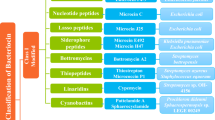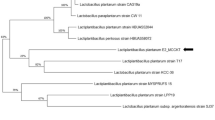Abstract
This study aimed to describe the diversity of antifungal lactic acid bacteria (LAB) in popular traditional Korean fermented food. A total of 22 LAB strains was selected and subjected to a monophasic identical approach using 16S rRNA gene sequence analysis. Antifungal LAB associated with fermented food was identified as Lactobacillus plantarum (9), Lactobacillus graminis (5), Lactobacillus pentosus (4), Lactobacillus sakei (2), Lactobacillus paraplantarum (1), and Leuconostoc mesenteroides subsp. mesenteroides (1). Novel Lactobacillus plantarum strain K46 exhibited comparatively better antifungal activity against several spoilage fungi, and was deposited in the Korean Collection for Type Cultures (KACC91758P). Antifungal substances from the spent medium in which K46 was cultivated were extracted with ethyl acetate. Antifungal activity was assessed using the broth micro dilution technique. Compounds were characterized based on infrared, 13C nuclear magnetic resonance (NMR), and 1H NMR spectral data. The minimum inhibitory concentration (MIC) of the compounds against Aspergillus clavatus, Aspergillus oryzae, Penicillium chrysogenum and Penicillium roqueforti was 2.5 mg/mL and that against Aspergillus fumigatus, Aspergillus niger, Curvularia lunata and Gibberella moniliformis was 5.0 mg/mL. K46 was able to survive gastrointestinal conditions simulating the stomach and the duodenum passage with the highest percentage of hydrophobicity. In addition, its resistance to hydrogen peroxide and highest hydroxyl radical and 2,2-diphenyl-1-picrylhydrazyl (DPPH) scavenging activities, with inhibition rates of 43.53 % and 56.88 %, respectively, were to its advantage. An antimicrobial susceptibility pattern was an intrinsic feature of this strain, thus consumption does not represent a health risk to humans. The results showed the potential of K46 strain as an antifungal, probiotic and antioxidant culture, and hence it was determined to be suitable for application in functional foods.




Similar content being viewed by others
References
Arasu MV, Duraipandiyan V, Ignacimuthu S (2013) Antibacterial and antifungal activities of polyketide metabolite from marine Streptomyces sp. AP-123 and its cytotoxic effect. Chemosphere 90:479–487
Bover-Cid S, Holzapfel WH (1999) Improved screening procedure for biogenic amine production by lactic acid bacteria. Int J Food Microbiol 53(1):33–41
Brul S, Coote P (1999) Preservative agents in foods: mode of action and microbial resistance mechanisms. Int J Food Microbiol 50:1–17
Buchmeier N, Bossie S, Chen CY, Fang FC, Guiney DG, Libby SJ (1997) SlyA, a transcriptional regulator of Salmonella typhimurium, is required for resistance to oxidative stress and is expressed in the intracellular environment of macrophages. Infect Immun 65:3725–3730
Charteris WP, Kelly PM, Morelli L, Collins JK (1998) Development and application of an in vitro methodology to determine the transit tolerance of potentially probiotic Lactobacillus and Bifidobacterium species in the upper human gastrointestinal tract. J Appl Microbiol 84:759–768
Citi JE, Sandime WE, Eliker PR (1963) Some observation on the Hull method for measurement of proteolysis in milk. J Dairy Sci 46:337–345
Coda R, Cassone A, Rizzello CG, Nionelli L, Cardinali G, Gobbetti M (2011) Antifungal activity of Wickerhamomyces anomalus and Lactobacillus plantarum during sourdough fermentation: identification of novel compounds and long-term effect during storage of wheat bread. Appl Environ Microbiol 77(10):3484–3492
Corsetti A, Settanni L (2007) Lactobacilli in sourdough fermentation. Food Res Int 40:539–558
Dal Bello F, Clarke CI, Ryan LAM, Ulmer H, Schober TJ, Strom K, Sjogren J, van Sinderen D, Schnurer J, Arendt EK (2007) Improvement of the quality and shelf-life of wheat bread by fermentation with the antifungal strain Lactobacillus plantarum FST 1.7. J Cereal Sci 45:309–318
Dieuleveux V, Lemarinier S, Gueguan M (1998) Antimicrobial spectrum and target site of d-3-phenyl lactic acid. Int J Food Microbiol 40:177–183
Filtenborg O, Frisvad J, Thrane U (1996) Moulds in food spoilage. Int J Food Microbiol 33:85–102
Fuller R (1992) Probiotics: the scientific basis. Chapman and Hall, London
Garofalo C, Silvestri G, Aquilanti L, Clementi F (2008) PCR-DGGE analysis of lactic acid bacteria and yeast dynamics during the production processes of three varieties of Panettone. J Appl Microbiol 105:243–254
Garofalo C, Zannini E, Aquilanti L, Silvestri G, Fierro O, Picariello G, Clementi F (2012) Selection of sourdough lactobacilli with antifungal activity for use as biopreservatives in bakery products. J Agric Food Chem 60(31):7719–7728
Georgieva R, Iliev I, Haertlé T, Chobert JM, Ivanova I, Danova S (2009) Technological properties of candidate probiotic Lactobacillus plantarum strains. Int Dairy J 19:696–702
Goldstein EJC, Citron DM, Merriam CV, Warren Y, Tyrrell LL (2000) Comparative in vitro activities of ertapenem (MK-0826) against 1001 anaerobes isolated from human intra-abdominal infections. Antimicrob Agents Chemother 44:2389–2394
Gourama H, Bullerman LB (1995) Antimycotic and antiaflatoxigenic effect of lactic acid bacteria: a review. J Food Prot 57:1275–1280
He ZS, Luo H, Cao CH, Cui ZW (2004) Photometric determination of hydroxyl free radical in Fenton system by brilliant green. Am J Clin Med 6:236–237
Jamaly N, Benjouad A, Bouksaim M (2011) Probiotic potential of Lactobacillus strains isolated from known popular traditional moroccan dairy products. Br Microbiol Res 1(4):79–94
Kao T, Chen B (2006) Functional components in soybean cake and their effects on antioxidant activity. J Agric Food Chem 54:7544–7555
Karunaratne A, Wezenberg E, Bullerman LB (1990) Inhibition of mould growth and aflatoxin production by Lactobacillus spp. J Food Prot 53:30–236
Kullisaar T, Songisepp E, Mikelsaar M, Zilmer K, Vihalemm T, Zilmer M (2003) Antioxidative probiotic fermented goats’ milk decreases oxidative stress-mediated atherogenicity in human subjects. Br J Nutr 90:449–456
Lavermicocca P, Valerio F, Evidente A, Lazzaroni S, Corsetti A, Gobbetti M (2000) Purification and characterization of novel antifungal compounds from sourdough Lactobacillus plantarum strain 21B. Appl Environ Microbiol 66:4084–4090
Lee J, Hwang K, Chung M, Cho D, Park C (2005) Resistance of Lactobacillus casei KCTC 3260 to reactive oxygen species (ROS): role for a metal ion chelating effect. J Food Sci 70:388–391
Lee H, Yoon H, Ji Y, Kim H, Park H, Lee J, Shin H, Holzapfel W (2011) Functional properties of Lactobacillus strains isolated from kimchi. Int J Food Microbiol 145:155–161
Legan JD (1993) Mold spoilage of bread: the problem and some solutions. Int J Biodeterior Biodegrad 32:33–53
Li S, Zhao Y, Zhang L, Zhang X, Huang L, Li D, Niu C, Yang Z, Wang Q (2012) Antioxidant activity of Lactobacillus plantarum strains isolated from traditional Chinese fermented foods. Food Chem 135:1914–1919
Lindgren SE, Dobrogosz WJ (1990) Antagonistic activities of lactic acid bacteria in food and feed fermentations. FEMS Microbiol Rev 87:149–164
Magnusson J, Strom K, Roos S, Sjogren J, Schnurer J (2003) Broad and complex antifungal activity among environmental isolates of lactic acid bacteria. FEMS Microbiol Lett 219:129–135
Maragkoudakis PA, Zoumpopoulou G, Miaris C, Kalantzopoulos G, Pot B, Tsakalidou E (2006) Probiotic potential of Lactobacillus strains isolated from dairy products. Int Dairy J 16:189–199
National Committee for Clinical Laboratory Standards (NCCLS) (1999). Document M31-A performance standards for antimicrobial disk and dilution susceptibility tests for bacteria isolated from animals, approved standard NCCLS, Villanova, p.57
O’Sullivan L, Ross RP, Hill C (2002) Potential of bacteriocin- producing lactic acid bacteria for improvements in food safety and quality. Biochimie 84:593–604
Pfeiler EA, Klaenhammer TR (2007) The genomics of lactic acid bacteria. Trends Microbiol 15:546–553
Pitt J (2000) Toxigenic fungi and mycotoxins. Br Med Bull 56:184
Prema P, Smila D, Palavesam A, Immanuel G (2008) Production and characterization of an antifungal compound (3-phenyllactic acid) produced by Lactobacillus plantarum strain. Food Bioprod Technol 3:379–386
Rose WM, Creighton MO, Stewart DHPJ, Sanwal M, Trevithick GR (1972) In vivo effects of vitamin E on cataractogenesis in diabetic rats. Can J Ophthalmol 17:61–66
Rossetti L, Carminati D, Zago M, Giraffa G (2009) A qualified presumption of safety approach for the safety assessment of Grana Padano whey starters. Int J Food Microbiol 130:70–73
Salminen S, Isolauri E, Salminen E (1996) Clinical use of probiotics for stabilizing the gut mucosal barrier: successful strains and future challenges. Antonie Van Leeuwenhoek 70:347–358
Schillinger U, Villarreal JV (2010) Inhibition of Penicillium nordicum in MRS medium by lactic acid bacteria isolated from foods. Food Control 21:107–111
Schnürer J, Magnusson J (2005) Antifungal lactic acid bacteria as biopreservatives. Trends Food Sci Technol 16:70–78
Smith J, Hong-Shum L (2003) Food additives data book. Blackwell Science, Oxford
Stiles ME (1996) Biopreservation by lactic acid bacteria. Antonie Van Leeuwenhoek 70:331–345
Strahinic I, Busarcevic M, Pavlica D, Milasin J, Golic N, Topisirovic L (2007) Molecular and biochemical characterizations of human oral lactobacilli as putative probiotic candidates. Oral Microbiol Immunol 22:111–117
Strom K, Sjogren J, Broberg A, Schnurer J (2002) Lactobacillus plantarum MiLAB 393 produces the antifungal cyclic dipeptides cyclo (l-Phe-l-Pro) and cyclo (l-Phetrans- 4-OH-l-Pro) and 3-phenyllactic acid. Appl Environ Microbiol 68:4322–4327
Succi M, Tremonte P, Reale A, Sorrentino E, Grazia L, Pacifico S, Coppola R (2005) Bile salt and acid tolerance of Lactobacillus rhamnosus strains isolated from Parmigiano Reggiano cheese. FEMS Microbiol 244:129–137
Temmerman R, Pot B, Huys G, Swings J (2003) Identification and antibiotic susceptibility of bacterial isolates from probiotic products. Int J Food Microbiol 81:1–10
Torkar KG, Vengust A (2008) The presence of yeasts, moulds and aflatoxin M1 in raw milk and cheese in Slovenia. Food Control 19:570–577
Vinderola CG, Reinheimer JA (2003) Lactic acid starter and probiotic bacteria: a comparative in vitro study of probiotic characteristics and biological barrier resistance. Food Res Int 36:895–904
Wang HK, Yan YH, Wang JM, Zhang HP, Qi W (2012) Production and characterization of antifungal compounds produced by Lactobacillus plantarum IMAU10014. PLOS ONE 7(1)
Zhang C, Brandt JM, Schwaba C, Gänzle GM (2010) Propionic acid production by cofermentation of Lactobacillus buchneri and Lactobacillus diolivorans in sourdough. Food Microbiol 27(3):390–395
Acknowledgments
We would like to thank Minister for Food, Agriculture, Forestry and Fisheries, for their support to carry out this project under the grant No. PJ008445. We also extend our gratitude to NIAS, RDA for their support.
Author information
Authors and Affiliations
Corresponding author
Rights and permissions
About this article
Cite this article
Arasu, M.V., Kim, D.H., Kim, P.I. et al. In vitro antifungal, probiotic and antioxidant properties of novel Lactobacillus plantarum K46 isolated from fermented sesame leaf. Ann Microbiol 64, 1333–1346 (2014). https://doi.org/10.1007/s13213-013-0777-8
Received:
Accepted:
Published:
Issue Date:
DOI: https://doi.org/10.1007/s13213-013-0777-8




